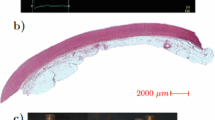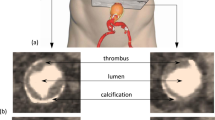Abstract
Blunt carotid artery injuries occur in 0.3% of blunt injured patients and may lead to devastating neurological consequences. However, arterial mechanics leading to internal layer subfailure have not been quantified. Twenty-two human carotid artery segments and 18 porcine thoracic aorta segments were opened to expose the intimal side and longitudinally distracted to failure. Porcine aortas were a geometrically accurate model of human carotid arteries. Internal layer subfailures were identified using videography and correlated with mechanical data. Ninety-three percent (93%) of vessels demonstrated subfailure prior to catastrophic failure. All subfailures occurred on the intimal surface. Initial subfailure occurred at 79% of the stress and 85% of the strain to catastrophic failure in younger porcine specimens, compared to 44% and 60%, respectively, in older human specimens. In most cases, multiple subfailures occurred prior to catastrophic failure. Due to limitations in human specimen quality (age, prior storage), young and fresh porcine aorta specimens are likely a more accurate model of clinical blunt carotid artery injuries. Present results indicate that vessels are acutely capable of maintaining physiologic function following initial subfailure. Delayed symptomatology commonly associated with blunt arterial injuries is explained by this mechanics-based and experimentally quantified onset of subcatastrophic failure.





Similar content being viewed by others
References
Adham M., J. P. Gournier, J. P. Favre, et al. (1996) Mechanical characteristics of fresh and frozen human descending thoracic aorta. J. Surg. Res. 64(1):32–34
Alimi Y., P. Di Mauro, L. Tomachot, et al. (1998) Bilateral dissection of the internal carotid artery at the base of the skull due to blunt trauma: incidence and severity. Ann. Vasc. Surg. 12(6):557–565
Ballard J. L., T. J. Bunt, B. Fitzpatrick, et al. (1992) Bilateral traumatic internal carotid artery dissections: case report. J. Vasc. Surg. 15(2):431–435
Batzdorf U., J. R. Bentson, H. I. Machleder (1979) Blunt trauma to the high cervical carotid artery. Neurosurgery 5(2):194–201
Biffl W. L., E. E. Moore, R. K. Ryu, et al. (1998) The unrecognized epidemic of blunt carotid arterial injuries: early diagnosis improves neurologic outcome. Ann. Surg. 228(4):462–470
Brossollet L. J., R. P. Vito (1997) The effects of cryopreservation on the biaxial mechanical properties of canine saphenous veins. J. Biomech. Eng. 119(1):1–5
Bujan J., G. Pascual, N. Garcia-Honduvilla, et al. (2000) Rapid thawing increases the fragility of the cryopreserved arterial wall. Eur. J. Vasc. Endovasc. Surg. 20(1):13–20
Carmines D. V., J. H. McElhaney, R. Stack (1991) A piece-wise non-linear elastic stress expression of human and pig coronary arteries tested in vitro. J. Biomech. 24(10):899–906
Carrillo E. H., D. L. Osborne, D. A. Spain, et al (1999) Blunt carotid artery injuries: difficulties with the diagnosis prior to neurologic event. J. Trauma 46(6):1120–1125
Cogbill T. H., E. E. Moore, M. Meissner, et al. (1994) The spectrum of blunt injury to the carotid artery: a multicenter perspective. J. Trauma 37(3):473–479
Cohuet G., P. Challande, M. Osborne-Pellegrin, et al. (2001) Mechanical strength of the isolated carotid artery in SHR. Hypertension 38(5):1167–1171
Collins R., W. C. L. Hu (1972) Dynamic deformation experiments on aortic tissue. J. Biomech. 5(4):333–337
Cothren C. C., E. E. Moore, W. L. Biffl, et al. (2004) Anticoagulation is the gold standard therapy for blunt carotid injuries to reduce stroke rate. Arch. Surg. 139(5):540–546
Cox R. H. (1979) Regional, species, and age related variations in the mechanical properties of arteries. Biorheology 16(1&2):85–94
Cox R. H. (1974) Three-dimensional mechanics of arterial segments in vitro: methods. J. Appl. Physiol. 36(3):381–384
Crissey M. M., E. F. Bernstein (1974) Delayed presentation of carotid intimal tear following blunt craniocervical trauma. Surgery 75(4):543–549
Davis J. W., T. L. Holbrook, D. B. Hoyt, et al. (1990) Blunt carotid artery dissection: incidence, associated injuries, screening, and treatment. J. Trauma 30(12):1514–1517
Fabian T. C., J. H. Patton, M. A. Croce, et al. (1996) Blunt carotid artery injury: importance of early diagnosis and anticoagulant therapy. Ann. Surg. 223(5):513–525
Fanelli F., F. M. Salvatori, R. Ferrari, et al. (2004) Stent repair of bilateral post-traumatic dissections of the internal carotid artery. J. Endovasc. Ther. 11(4):517–521
Gournier J. P., M. Adham, J. P. Favre, et al. (1993) Cryopreserved arterial homografts: preliminary study. Ann. Vasc. Surg. 7(6):503–511
Gurdjian E. S., B. Audet, R. W. Sibayan, et al. (1971) Spasm of the extracranial internal carotid artery resulting from blunt trauma demonstrated by angiography. J. Neurosurg. 35(6):742–747
Hayashi K. (1993) Experimental approaches on measuring the mechanical properties and constitutive laws of arterial walls. J. Biomech. Eng. 115(4B):481–488
Krajewski L. P., N. R. Hertzer (1980) Blunt carotid artery trauma. Ann. Surg. 191(3):341–346
Lacolley P., P. Challande, S. Boumaza, et al. (2001) Mechanical properties and structure of carotid arteries in mice lacking desmin. Cardiovasc. Res. 51(1):178–187
Lawton R. W. (1955) Measurements on the elasticity and damping of isolated aortic strips in the dog. Circ. Res. 3(4):403–408
Lee M. C., R. C. Haut (1989) Insensitivity of tensile failure properties of human bridging veins to strain rate: implications in biomechanics of subdural hematoma. J. Biomech. 22(6/7):537–542
Lee M. C., R. C. Haut (1992) Strain rate effects on tensile failure properties of the common carotid artery and jugular veins of ferrets. J. Biomech. 25(8):925–927
L’Italien G. J., R. D. Maloney, W. M. Abbott (1979) The preservation of the mechanical properties of venous allografts by freezing. J. Surg. Res. 27(4):239–243
Liu W. P., K. C. Ng, J. J. Hung (2005) Carotid artery injury with cerebral infarction following head and neck blunt trauma: report of a case. Yale J. Biol. Med. 78(3):151–156
Lowenhielm P. (1974) Dynamic properties of the parasagittal bridging veins. Z. Rechtsmed. 74(1):55–62
Malek A. M., R. T. Higashida, C. C. Phatouros, et al. (2000) Endovascular management of extracranial carotid artery dissection achieved using stent angioplasty. AJNR Am. J. Neuroradiol. 21(7):1280–1292
Malin J. P., H. Becker, J. Abicht (1985) Bilateral traumatic extracranial aneurysms of the internal carotid artery with delayed brain infarction. J. Neurol. 232(5):314–317
Martin R. F., J. Eldrup-Jorgensen, D. E. Clark, et al. (1991) Blunt trauma to the carotid arteries. J. Vasc. Surg. 14(6):789–795
McKevitt E. C., A. W. Kirkpatrick, L. Vertesi, et al. (2002) Blunt vascular neck injuries: diagnosis and outcomes of extracranial vessel injury. J. Trauma 53(3):472–476
Miller P. R., T. C. Fabian, T. K. Bee, et al. (2001) Blunt cerebrovascular injuries: diagnosis and treatment. J. Trauma 51(2):279–285
Miller P. R., T. C. Fabian, M. A. Croce, et al. (2002) Prospective screening for blunt cerebrovascular injuries. Ann. Surg. 236(3):386–395
Mitchell P., J. Jakubowski (2002) Failure testing cerebral arteries: are branch points weaker than unbranched vessels? Br. J. Neurosurg. 16(6):578–582
Mohan D., J. W. Melvin (1982) Failure properties of passive human aortic tissue. I. Uniaxial tension tests. J. Biomech. 15(11):887–902
Mokri B., D. G. Piepgras, O. W. Houser (1988) Traumatic dissections of the extracranial internal carotid artery. J. Neurosurg. 68(2):189–197
Monson K. L., W. Goldsmith, N. M. Barbaro, et al. (2003) Axial mechanical properties of fresh human cerebral blood vessels. J. Biomech. Eng. 125(2):288–294
Monson K. L., W. Goldsmith, N. M. Barbaro, et al. (2005) Significance of source and size in the mechanical response of human cerebral blood vessels. J. Biomech. 38(4):737–744
Parikh A. A., F. A. Luchette, J. F. Valente, et al. (1997) Blunt carotid artery injuries. J. Am. Coll. Surg. 185(1):87–93
Perry M. O., W. H. Snyder, E. R. Thal (1980) Carotid artery injuries caused by blunt trauma. Ann. Surg. 192(1):74–77
Prall J. A., K. E. Brega, D. M. Coldwell, et al. (1998) Incidence of unsuspected blunt carotid artery injury. Neurosurgery 42(3):495–499
Pretre R., A. Reverdin, T. Kalonji, et al. (1994) Blunt carotid artery injury: difficult therapeutic approaches for an underrecognized entity. Surgery 115(3):375–381
Pukacki F., T. Jankowski, M. Gabriel, et al. (2000) The mechanical properties of fresh and cryopreserved arterial homografts. Eur. J. Vasc. Endovasc. Surg. 20(1):21–24
Punjabi A. P., B. R. Plaisier, R. H. Haug, et al. (1997) Diagnosis and management of blunt carotid artery injury in oral and maxillofacial surgery. J. Oral. Maxillofac. Surg. 55(12):1388–1395
Rosset E., A. Friggi, G. Novakovitch, et al. (1996) Effects of cryopreservation on the viscoelastic properties of human arteries. Ann. Vasc. Surg. 10(3):262–272
Sauren A. A. H. J., M. C. van Hout, A. A. van Steenhoven, et al. (1983) The mechanical properties of porcine aortic valve tissue. J. Biomech. 16(5):327–337
Scherman B. M., W. S. Tucker (1982) Bilateral traumatic thrombosis of the internal carotid arteries in the neck: a case report with review of literature. Neurosurgery. 10(6):751–753
Showalter D., S. Durham, R. Sheppeck, et al. (1989) Cryopreserved venous homografts as vascular conduits in canine carotid arteries. Surgery. 106(4):652–659
Stemper B. D., M. R. Stineman, N. Yoganandan, et al. (2005) Subcatastrophic failure characteristics of the porcine descending aorta. Biomed. Sci. Instrum. 41:110–115
Stemper B. D., N. Yoganandan, and F. A. Pintar. Mechanics of arterial subfailure with increasing loading rates. J. Biomech. doi:10.1016/j.jbiomech.2006.07.005, in press
Stemper B. D., N. Yoganandan, F. A. Pintar (2005) Methodology to study intimal failure mechanics in human internal carotid arteries. J. Biomech. 38(12):2491–2496
Stemper B. D., N. Yoganandan, M. R. Stineman, et al. Mechanics of fresh, refrigerated, and frozen arterial tissue. J Surg Res. doi:10.1016/j.jss.2006.09.001, in press
Stonebridge P. A., A. E. Clason, A. M. Jenkins (1990) Traumatic aneurysm of the extracranial internal carotid artery due to hyperextension of the neck. Eur. J. Vasc. Surg. 4(4):423–425
Stringer W. L., D. L. Kelly (1980) Traumatic dissection of the extracranial internal carotid artery. Neurosurgery 6(2):123–130
Tanaka T., Y. C. Fung (1974) Elastic and inelastic properties of the canine aorta and their variation along the aortic tree. J. Biomech. 7(4):357–370
van Andel C. J., P. V. Pistecky, C. Borst (2003) Mechanical properties of porcine and human arteries: implications for coronary anastomotic connectors. Ann. Thorac. Surg. 76(1):58–65
Wahl W. L., M. M. Brandt, G. Thompson, et al. (2002) Antiplatelet therapy: an alternative to heparin for blunt carotid injury. J. Trauma 52(5):896–901
Wang P., Z. Shu, L. He, et al. (2006) The structural and cellular viability in cryopreserved rabbit carotid arteries. J. Surg. Res. 131(2):241–251
Xie J., J. Zhou, Y. C. Fung (1995) Bending of blood vessel wall: stress–strain laws of the intima-media and adventitial layers. J. Biomech. Eng. 117(1):136–145
Zelenock G. B., A. Kazmers, W. M. Whitehouse, et al. (1982) Extracranial internal carotid artery dissections: noniatrogenic traumatic lesions. Arch. Surg. 117(4):425–432
Acknowledgments
This research was supported in part by the Department of Veterans Affairs Medical Research. The funding for this research has also been provided in part by an Australian Research Council linkage grant and by private parties, who have selected Dr. Kennerly Digges and FHWA/NHTSA National Crash Analysis Center at the George Washington University to be an independent solicitor of and funder for research in motor vehicle safety, and to be one of the peer reviewers for the research projects and reports. Neither of the private parties have determined the allocation of funds or had any influence on the content of this report.
Author information
Authors and Affiliations
Corresponding author
Rights and permissions
About this article
Cite this article
Stemper, B.D., Yoganandan, N., Sinson, G.P. et al. Biomechanical Characterization of Internal Layer Subfailure in Blunt Arterial Injury. Ann Biomed Eng 35, 285–291 (2007). https://doi.org/10.1007/s10439-006-9229-y
Received:
Accepted:
Published:
Issue Date:
DOI: https://doi.org/10.1007/s10439-006-9229-y




